Dr Blaire Morgan and Dr Laura Simmons have created a wellbeing programme for University staff consisting of five-daily themes with a range of short intentional activities for you to participate in.
This wellbeing programme is inspired by Martin Seligman’s (2011) PERMA framework, one of the most prolific models for wellbeing within Positive Psychology. The PERMA framework considers wellbeing to be broadly comprised of five facets: Positive emotions (hedonic feelings of happiness such as joy and contentment), Engagement (feeling absorbed and engaged in life and connected to activities/organisations), positive Relationships (feeling socially integrated, cared about and supported by others), Meaning or purpose (believing that one’s life is valuable and feeling connected to something greater than oneself), and a sense of Accomplishment (making progress toward goals, feeling capable).
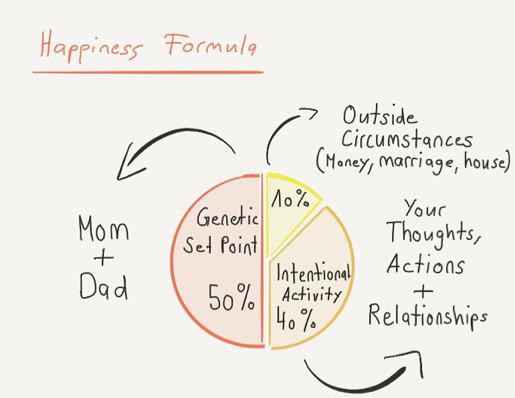
The PERMA models suggests that we flourish through balancing the Pleasant Life (feeling good or hedonic wellbeing) with the Meaningful Life (having purpose, contribution and belonging, or eudaimonic wellbeing).
Whilst external circumstances can often be out of your control, or difficult to change in a short period of time, research suggests that approximately 40% of your happiness levels can be influenced by the intentional activities that you engage in (Lyubomirsky, Sheldon, & Schkade, 2005).
This wellbeing programme will consist of five-daily themes with a range of short intentional activities for you to participate in.
The week will be structured as follows:
Person-Activity Fit Diagnostic:
Given that everyone has different preferences and skills, there will be variance in across individuals in terms of what wellbeing activities work for them, and which activities they will be willing to try out. Therefore, we have outlined a choice of wellbeing activities each day for you to choose from.
You may find it useful to use this person-activity fit tool to work out the kinds of wellbeing activities that could work for you.
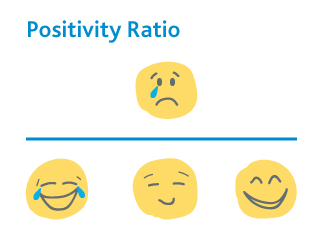
Researchers have suggested that the ideal ratio of 'positive' to 'negative' emotions is 3:1. Note here that this ratio is not 3:0 - negative emotions are still important. We therefore advise against focusing solely on increasing positive emotion without identifying and reflecting on the negative emotions you experience during the week.
If you are interested, this TED talk outlines the positivity ratio in more detail: Barbara Fredrickson: The Positivity Ratio, and this TED Talk outlines the dangers of only focusing on the positive and ignoring negative emotions: The risk of positive thinking – the danger to ignore emotions and their messages
Monday
Creating Positive Emotions:
In positive psychology, and in psychometric measures of positive affect and subjective wellbeing, the following emotions are considered positive in valence:
- Joy
- Pride
- Hope
- Awe
- Gratitude
- Love
- Interest
- Amusement
- Serenity/Contentment
- Inspiration
Experiencing these emotions can boost the amount of cognitive, social and physical resources that you have available to you. Research suggests that once you start to cultivate positive emotions, you are subsequently more able to experience them again in the future – creating an ‘upward spiral’ of positivity.
Read more about science behind positive emotions.
Monday: Activities to Boost Positive Emotion
Below are a series of short activities designed to boost your level of positive affect. The number you engage with is up to you, and it is not necessary for you to complete all of them. You might consider using the Person-Activity Fit Diagnostic to identify which activity is likely to be a good fit for you (see above).
Activity 1: Feel good playlist
Listening to music is an effective way of boosting positive affect; there is a long history of music being used as a way of inducing positive mood in psychology experiments and neuroimaging studies.
Why not spend some time creating your own playlist of songs that make you feel good.
Activity 2: Things that make us happy
Post pictures of the things that make you happy to this padlet! Pets, Nature, (unidentifiable) People, Art, Bands, Food, Places. Here is one of our examples of things that make us happy.
Activity 3: Three Positive Things
Below are three simple exercises that take approximately 5-10 minutes to complete. We have signposted three versions of the exercise for you to choose from:
Three Good Things
What this involves:
- Writing down three things that have gone well once a day for one week.
- You might find it helpful to reflect on why these things went well.
- You should make a physical record each day rather than simply thinking about this in your head
How it works: This exercise encourages you to find and focus on the positive in your life. Research has suggested that once you start to focus on positive elements and memories, these become more accessible to you (Fredrickson, 2001; Watkins, 2011). Because positive emotions broaden your thought repertoire and build social, cognitive, and physical resources, this type of exercise tends to get easier over time. This is also true of the adaptations to this exercise that you can see below.
Here is one example of the three good things exercise that you can use
Three Funny Things
Adaptation to the original three good things exercise:
- Write down the three funniest things you have heard, seen, done, or experienced today.
- Reflect on how these things made you feel and why they were funny.
A template for this exercise can be followed here
Three Proud Things
Another adaptation to the Three Good Things Exercise:
- Write down three things that you are proud of accomplishing, once a day for a week. These don't need to big things (e.g., 'I'm proud of getting out of the house for a walk today' would be a legitimate item).
- Reflect on how these accomplishments made you feel and whether they have motivated you to engage in similar behaviours again.
Tuesday
Gratitude and Positive Reframing:
Gratitude is considered a positive and prosocial emotion which involves recognising the benefits one has in their life, typically with reference to the person(s) who provided this benefit (McCullough et al., 2001; Tsang, 2006).
Why Practice Gratitude?
It makes you feel good: Gratitude is a positive emotion that 'broadens and builds’.
It makes you feel connected: Gratitude has a social bonding function that helps build and maintain relationships (it is linked to the release of the hormone oxytocin).
It makes others feel good too: Through expression, gratitude can pass on from person-to-person and create an upward spiral of positivity.
Read more about the benefits of gratitude
Tuesday: Activities to Boost Gratitude
Below are a series of short activities designed to boost gratitude. The number you engage with is up to you, and it is not necessary for you to complete all of them. You might consider using the Person-Activity Fit Diagnostic to identify which activity is likely to be a good fit for you (see above)
Activity 1: Counting Blessings
This is the most prolific gratitude exercise which has been incorporated into clinical treatments and used in wellbeing interventions globally (Davis et al., 2016). It is a very simple exercise that takes just 5 minutes a day:
Write down three things that you are grateful for today
- It is important that you make a physical note of this, rather than just reflecting on what you grateful for. You could make use of a gratitude app or keep a gratitude diary.
How often should I do this, and for how long? This activity can be done daily with positive effects on wellbeing noted after just one week. You may choose to continue with this exercise for longer (some people continue with this simple act of counting blessings every day of their lives). The positive effects of this exercise can wear off though (because of something called 'hedonic adaptation' where we get used to this new influx of happiness and it no longer has the same effect). Therefore, you could choose to alter the frequency with which you engage in this activity to be every other day or once a week. You can, of course, choose to take a break from this exercise and then pick it up again when you are ready.
Here are some instructions from a gratitude intervention that might help you to follow this exercise:
‘Gratitude is an emotion expressed in response to kind actions from another. Please write down three things that you are grateful for today. For example, I am grateful for a gift received from another person, I am grateful for my colleague making me a cup of tea, I am grateful for my friend helping me with my essay.’
(Instructions from: Gulliford, L., Morgan, B., Hemming, E., & Abbott, J. (2019). Gratitude, self-monitoring and social intelligence: A prosocial relationship?. Current Psychology, 38(4), 1021-1032).
Gratitude Diary Apps:
This website (updated March 2020), lists various apps that you might consider downloading and using to practice gratitude on a regular basis
Activity 2: Gratitude Wall
Padlet link
Research has indicated that sharing our grateful reflections with others can boost subjective wellbeing and facilitate the ‘upward spiral’ of gratitude where grateful feelings can be passed onto others (Algoe, 2012; McCullough et al., 2001).
Therefore, this exercise involves posting your reflections on what you have to be grateful for on a padlet so that others can see them too. In the padlet you are asked to reflect on the past week, and add to the following columns:
- 'I am grateful to ... for ...' (a more typical gratitude reflection that considers a benefit received from another person)
- 'I am grateful for ...' (no specific person/benefactor necessary here)
- 'I am grateful that...' (this might be gratitude for a circumstance, situation or event that has transpired)
Activity 3: Gratitude Letter
This activity involves expressing gratitude to another person. You should:
- Think of a person that you are grateful to, whom you perhaps didn’t express gratitude towards at the time, or you feel that you haven’t expressed sufficient gratitude towards
- Write a heartfelt letter of thanks to that person
- Send your letter to the intended recipient
Here is some helpful guidance on completing the exercise (with the caveat that the physical delivery of this letter is likely not possible in the current circumstances)
Positive reframing
These exercises are designed to ‘undo the negativity bias’, where we are biased towards attending to the negative events and emotions and in our lives rather than the positive (Huang & Luo, 2006; Vaish et al., 2008). (For example, on receiving feedback from others, we might focus on the more negative parts of the feedback over the positive – even if there is much more positive feedback than negative!). Rather than interpreting events with a negative mindset, positive reframing involves considering the positive elements to the current situation: you reframe the event so that it is not solely negative.
(Important Caveat: The negative elements should not be ignored and simply replaced with positive - remember the positivity ratio and dangers of focusing only on the positive)
Activity 4: Positive Reframing
Take a moment to reflect on your current living and working arrangements. Whilst these have changed in comparison to the typical academic year, are there any positive elements you can take from this situation?
Wednesday
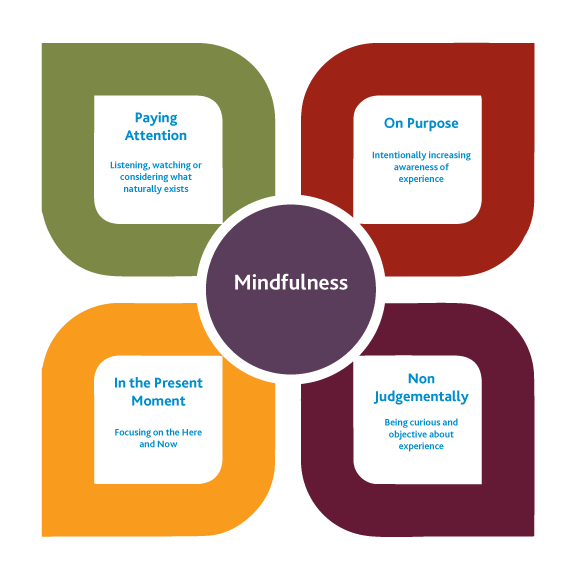
Mindfulness and Self-Compassion
Mindfulness is:
- “Paying attention on purpose, moment by moment, without judging” (Jon Kabat-Zinn)
- Something involving focused attention, decentering and emotion regulation
- A ‘preventative measure’ as it alleviates stress and promotes wellbeing
How does it work?
- Top-Down Pathway – mindfulness recruits stress-regulatory regions of the pre-frontal cortex to inhibit stress processing
- Bottom-up Pathway – mindfulness alters structure and function of amygdala (thus calming the fight or flight response)
Please note:
- It can take a while to find a mindfulness exercise that works for you!
- It can be challenging – it’s a skill…
- It doesn’t work for everyone, and can be stress-inducing at first
- Effects can wear off (variety might be key here)
- Longer-term effects are still largely unknown!
What is Self-Compassion?
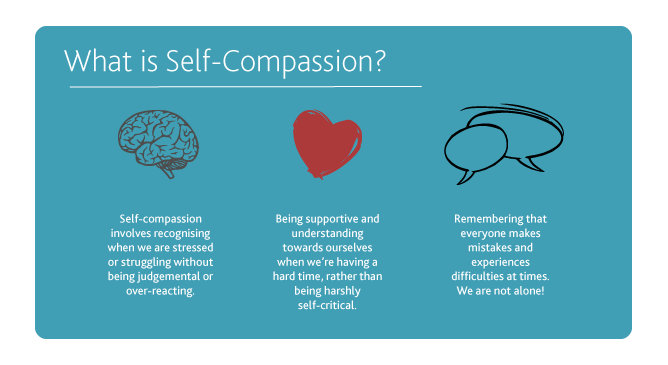
Wednesday: Activities for Mindfulness and Self-compassion
Below are a series of short activities designed to boost mindfulness and self-compassion. The number you engage with is up to you, and it is not necessary for you to complete all of them. You might consider using the Person-Activity Fit Diagnostic to identify which activity is likely to be a good fit for you (see above).
To find out more about the science behind these activities, please see the following articles:
- Neff, K. D., & Germer, C. K. (2013). A piolet study and randomized controlled trial of the mindful self-compassion program. Journal of Clinical Psychology, 69(1), 28-44.
Thursday
Stress and Resilience
Today’s session will focus on stress and resilience. Stress is a physiological and/or psychological reaction to a stressor (i.e. a situation or event that can cause stress). There are a range of physical and psychological symptoms of stress including, increased heart rate, sweating, anger, depression and a lack of motivation to name a few.
Stress is a natural part of our daily lives, but we might sometimes want to use strategies to help overcome the negative effects of stress. Resilience is an ability to ‘bounce back’ from stress or other difficulties and helps you adapt to changes in life. To begin, you might find it helpful to watch a TedTalk on the Power of Perseverance:
Thursday: Activities for Stress and Resilience
Below are a series of short activities designed to reduce stress and cultivate resilience. The number you engage with is up to you, and it is not necessary for you to complete all of them. You might consider using the Person-Activity Fit Diagnostic to identify which activity is likely to be a good fit for you (see above).
- Activity 1: Writing to manage stress (expressive writing). Think about something you’re finding particularly challenging at the moment. Write about it for 15- 20 minutes
- Activity 2: Music can have an impact on our emotions, particularly calming music – Think about the music that you find calming/relaxing and create/listen to the playlist
To find out more about the science behind these activities, please see the following articles:
- Baikie, K. A., & Wilhelm, K. (2005). Emotional and physical health benefits of expressive writing. Advances in Psychiatric Treatment, 11(5), 338-346.
- Pelletier, C. L. (2004). The Effect of Music on Decreasing Arousal Due to Stress: A Meta-Analysis. Journal of Music Therapy, 41(3), 192-214.
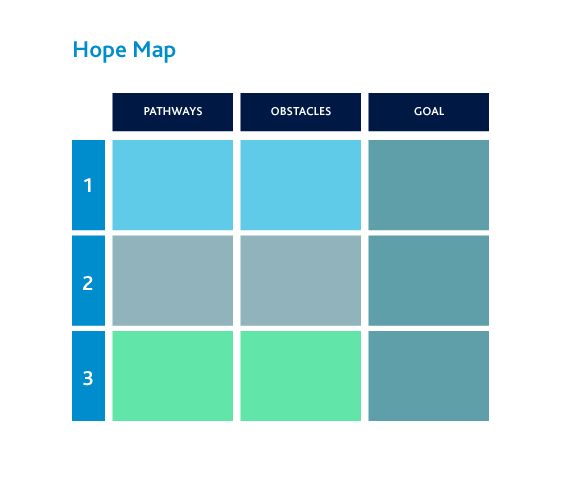 The Hope Map is an activity designed by Michelle McQuaid
The Hope Map is an activity designed by Michelle McQuaid
Friday
Hope and Optimism
Hope and Optimism involve focusing on planning for the future - individuals who have high levels of hope and optimism are likely to view their futures as being prosperous. Hope involves planning and meeting future goals and maintaining a positive motivational state (Snyder, 1994; 2000), and optimism involves favourable interpretations of the past and present (Foregeard & Seligman, 2012).
To find out more about the science behind today's "Best Possible Selves" activity, please see the following article:
Loveday, P. M., Lovell, G. P., & Jones, C. M. (2018). The best possible selves intervention: A review of the literature to evaluate efficacy and guide future research. Journal of Happiness Studies, 19, 607 – 628.
Friday: Activities to Promote Hope and Optimism
Below are a series of short activities designed to boost hope and optimism. The number you engage with is up to you, and it is not necessary for you to complete all of them. You might consider using the Person-Activity Fit Diagnostic to identify which activity is likely to be a good fit for you (see above).
Activity 1: The “Best Possible Selves” practice: Each of these exercises asks you to consider a different life domain (family life, career, physical and mental health, romantic life, interests/hobbies, social life).
This intervention is designed so that you consider one domain per week for six weeks, however, you can also choose to focus on fewer domains over a shorter period. A wide range of studies have shown that these best possible selves exercises can encourage individuals to be more optimistic about their futures.
Activity 2: Hope is effective in helping you make changes in behaviour. By creating a hope map, you can visualise your goals, whilst thinking about the pathways and obstacles to that goal. Create your own hope map by Michelle McQuaid:
- Take a piece of paper and place it horizontally on your desk. Then fold it into three sections and open it up once more so that you have a grid.
- On the far right third of the page write the heading “Goals”. Then note down below a goal you’re hoping to achieve.
- Then on the far left third of the page write the heading “Pathways”. Try to note down at least three different pathways you’ll need to initiate to reach your goal and make your hopes a reality.
- Then in the middle third of the page write the heading “Obstacles”. Try to note down at least one obstacle for each of the pathways you’ve identified that may make your hopes more difficult. Researchers have found that we are more likely to succeed when we plan for possible obstacles at the outset of our journey.
- Finally around the edges of your page note down how you can do to maintain your motivation and will power to complete the pathways and achieve your hopes. How will you make the journey enjoyable? Which strengths can you use? Who will encourage you? How will you measure your progress?